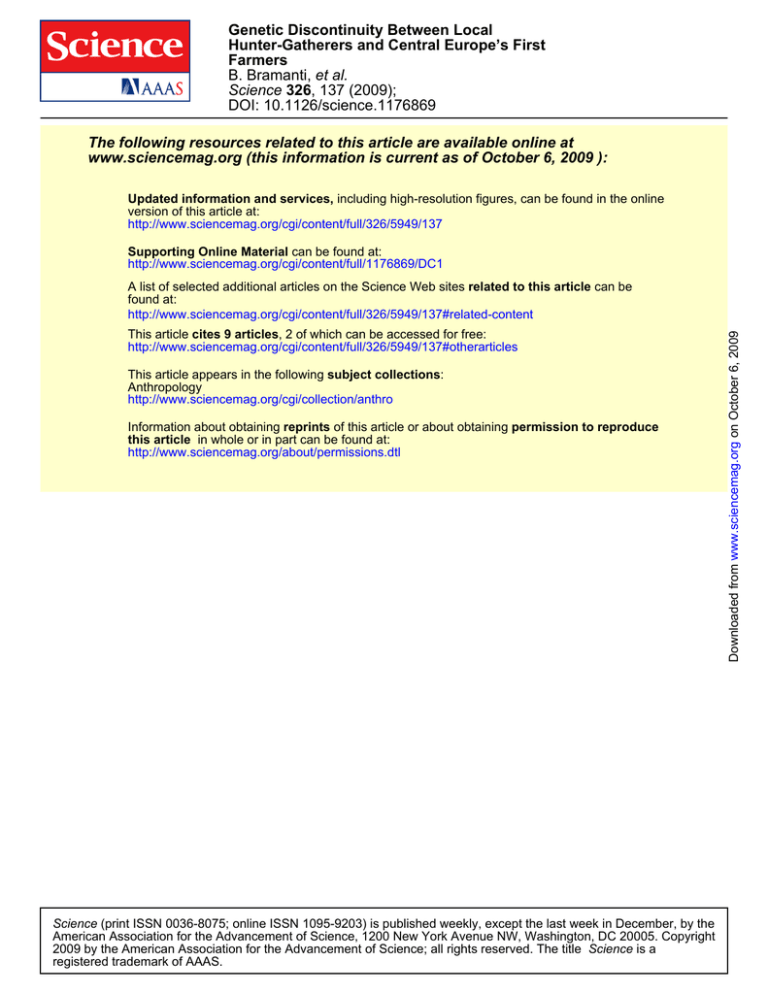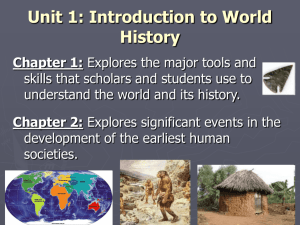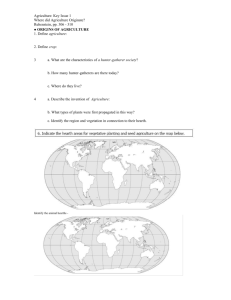
Genetic Discontinuity Between Local
Hunter-Gatherers and Central Europe’s First
Farmers
B. Bramanti, et al.
Science 326, 137 (2009);
DOI: 10.1126/science.1176869
The following resources related to this article are available online at
www.sciencemag.org (this information is current as of October 6, 2009 ):
Updated information and services, including high-resolution figures, can be found in the online
version of this article at:
http://www.sciencemag.org/cgi/content/full/326/5949/137
Supporting Online Material can be found at:
http://www.sciencemag.org/cgi/content/full/1176869/DC1
This article cites 9 articles, 2 of which can be accessed for free:
http://www.sciencemag.org/cgi/content/full/326/5949/137#otherarticles
This article appears in the following subject collections:
Anthropology
http://www.sciencemag.org/cgi/collection/anthro
Information about obtaining reprints of this article or about obtaining permission to reproduce
this article in whole or in part can be found at:
http://www.sciencemag.org/about/permissions.dtl
Science (print ISSN 0036-8075; online ISSN 1095-9203) is published weekly, except the last week in December, by the
American Association for the Advancement of Science, 1200 New York Avenue NW, Washington, DC 20005. Copyright
2009 by the American Association for the Advancement of Science; all rights reserved. The title Science is a
registered trademark of AAAS.
Downloaded from www.sciencemag.org on October 6, 2009
A list of selected additional articles on the Science Web sites related to this article can be
found at:
http://www.sciencemag.org/cgi/content/full/326/5949/137#related-content
REPORTS
Genetic Discontinuity Between Local
Hunter-Gatherers and Central Europe’s
First Farmers
B. Bramanti,1* M. G. Thomas,2 W. Haak,1† M. Unterlaender,1 P. Jores,1‡ K. Tambets,3
I. Antanaitis-Jacobs,4 M. N. Haidle,5 R. Jankauskas,4 C.-J. Kind,6 F. Lueth,7 T. Terberger,8
J. Hiller,9§ S. Matsumura,10,11∥P. Forster,12 J. Burger1
circa (ca.) 13,400 to 2300 B.C.E. and includes
bones from Hohler Fels in the Ach valley (Late
Upper Paleolithic) and Hohlenstein-Stadel in the
Lone valley (Mesolithic). Extensive precautions
were taken to ensure sequence authenticity (14),
including extracting independent samples from
different skeletal locations of the same individuals and examining remains only from high
latitudes or cave sites with good biomolecular
preservation.
1
urope has witnessed several changes in
archaeological cultures since anatomically
modern humans displaced the Neandertal
population 30,000 to 40,000 years ago (1, 2).
Palaeolithic hunter-gatherers survived the Last
Glacial Maximum (LGM) about 25,000 years
ago in southern and eastern refugia (3) and resettled central Europe after the retreat of the ice
sheets. With the end of the Ice Age at ~9600 B.C.E.,
their Mesolithic descendants or successors had
recolonized large parts of the deglaciated northern latitudes (4, 5). From around 6400 B.C.E.,
the hunter-gatherer way of life gave way to
farming cultures in a transition known as the Ne-
E
olithic Revolution (6). The extent to which this
important cultural transition was mediated by the
arrival of new peoples, and the degree of Mesolithic and early Neolithic ancestry in Europeans
today, have been debated for more than a century
(7–10). To address these questions directly, we
obtained mitochondrial DNA (mtDNA) types from
22 central and northern European post-LGM
hunter-gatherer skeletal remains (Fig. 1) and compared 20 of these (those for which full sequence
information was available) to homologous mtDNA
sequences from 25 early farmers (11, 12) and 484
modern Europeans from the same geographic region (13). Our ancient sample spans a period from
Fig. 1. mtDNA types
from prehistoric samples
of hunter-gatherers and
farmers. The green shading represents the first
farming areas [dark
green: early LBK, 5650
to 5400 calibrated years
B.C.E. (calBC); light
green: LBK, 5400 to
4900 calBC] in central
Europe, based on archaeological finds, whereas
squares represent successfully analyzed Late
Palaeolithic, Mesolithic,
and Ceramist huntergatherers dating from
13,400 to 2300 B.C.E.
The term “Neolithic” is
sometimes applied to the
Eastern European Ceramist culture because of their use of pottery, but this does not imply a farming
economy (21). Previously analyzed (11, 12) LBK farming sites are marked with
circles for comparison. The area of each square or circle is proportional to the
number of individuals successfully investigated. In red are labeled archaeological sites with one or more U4/U5 individuals; in yellow, sites with other mtDNA
types, highlighting the specificity of U types in the prehistoric hunter-gatherers.
www.sciencemag.org
SCIENCE
Institute for Anthropology, University of Mainz, Mainz,
Germany. 2Research Department of Genetics, Evolution and
Environment, and the Arts and Humanities Research Council
Centre for the Evolution of Cultural Diversity, University College
London, Gower Street, London WC1E 6BT, UK. 3Department of
Evolutionary Biology, Institute of Molecular and Cell Biology,
University of Tartu and Estonian Biocentre, Tartu, Estonia.
4
Department of Anatomy, Histology and Anthropology,
University of Vilnius, Lithuania. 5Research Center “The Role
of Culture in Early Expansions of Humans” of the Heidelberg
Academy of Sciences and Humanities, Senckenberg Research
Institute, Frankfurt am Main, Germany. 6Regierungspräsidium
Stuttgart, Landesamt für Denkmalpflege, Germany. 7RömischGermanische Kommission (RGK), Frankfurt am Main, Germany.
8
Lehrstuhl für Ur- und Frühgeschichte, University of Greifswald,
Germany. 9Biophysics Group, Cardiff School of Optometry and
Vision Sciences, Cardiff University, Cardiff, UK. 10International
Institute for Applied Systems Analysis, Laxenburg, Austria.
11
Leibniz-Institute of Freshwater Ecology and Inland Fisheries,
Berlin, Germany. 12Cambridge Society for the Application of
Research, Cambridge, UK.
Downloaded from www.sciencemag.org on October 6, 2009
After the domestication of animals and crops in the Near East some 11,000 years ago, farming
had reached much of central Europe by 7500 years before the present. The extent to which these early
European farmers were immigrants or descendants of resident hunter-gatherers who had adopted
farming has been widely debated. We compared new mitochondrial DNA (mtDNA) sequences from late
European hunter-gatherer skeletons with those from early farmers and from modern Europeans. We
find large genetic differences between all three groups that cannot be explained by population
continuity alone. Most (82%) of the ancient hunter-gatherers share mtDNA types
that are relatively rare in central Europeans today. Together, these analyses provide persuasive evidence
that the first farmers were not the descendants of local hunter-gatherers but immigrated into central
Europe at the onset of the Neolithic.
*To whom correspondence should be addressed. E-mail:
bramanti@uni-mainz.de
†Present address: Australian Centre for Ancient DNA, University of Adelaide, Adelaide, Australia.
‡Present address: Institute for Zoology, University of Mainz,
Mainz, Germany.
§Present address: Diamond Light Source, Harwell Science
and Innovation Campus, Chilton, UK.
∥ Present address: Faculty of Applied Biological Sciences,
Gifu University, Gifu, Japan.
The sites are as follows: 1, Ostorf; 2, Bad Dürrenberg; 3, Falkensteiner Höhle; 4,
Hohler Fels; 5, Hohlenstein-Stadel; 6, Donkalnis; 7, Spiginas; 8, Dudka; 9,
Kretuonas; 10, Drestwo; 11, Chekalino; 12, Lebyazhinka; 13, Unseburg; 14,
Unterwiederstedt; 15, Derenburg/Meerenstieg; 16, Eilsleben; 17, Halberstadt;
18, Seehausen; 19, Flomborn; 20, Vaihingen an der Enz; 21, Schwetzingen;
22, Asparn/Schletz; 23, Ecsegfalva.
VOL 326
2 OCTOBER 2009
137
138
(7), but the frequencies found here are surprisingly high. Europeans today have moderate frequencies of U5 types, ranging from about 1 to
5% along the Mediterranean coastline to 5 to 7%
in most core European areas, and rising to 10 to
20% in northeastern European Uralic speakers,
with a maximum of over 40% in the Scandinavian
Saami. U4 types show frequencies between 1 and
5% in most parts of Europe, with Western Europe
at the lower end of this range and northeastern
Europe and central Asia showing percentages in
excess of 7% (13).
The diversity among the hunter-gatherer U
types presented here, together with their continued presence over 11 millennia, and the fact that
U5 is rare outside Europe, raises the possibility
that U types were common by the time of the
post-LGM repopulation of central Europe, which
started around 23,000 years ago (3). In a previous
study, we showed that the early farmers of central
Europe carried mainly N1a, but also H, HV, J, K,
Ne at colonization of Europe 45,000 BP
1000
23000
45000
67000
89000
Ne at onset of LBK 7,500 BP
1110 2210 3310 4410
B
10
10
1110 2210 3310 4410
A
1000
23000
45000
67000
89000
Ne at onset of LBK 7,500 BP
C
1110 2210 3310 4410
0.05
0.04
0.03 Probability of obtaining
FST value greater
0.02 than that observed
10
0.01
0.00
1000
23000
45000
67000
89000
Ne at onset of LBK 7,500 BP
Fig. 2. Probabilities of obtaining observed genetic differences, as measured by FST, between (A) huntergatherers and LBK early farmers, (B) hunter-gatherers and modern Europeans, and (C) LBK early farmers
and modern Europeans, across a range of assumed ancestral population size combinations. Two phases of
exponential growth were considered, the first after the initial colonization of Europe 45,000 years ago, of
assumed effective female population size NUP (y axis), and ending when farming began in central Europe
7500 years ago, when the assumed effective female population size was NN (x axis); and the second
leading up to the present, when the assumed effective female population size is 12 million. The initial
colonizers of Europe were sampled from a constant ancestral African population of 5000 effective
females. The FST values are those observed from the data presented in this study. Black shaded areas
indicate probabilities >0.05.
2 OCTOBER 2009
VOL 326
SCIENCE
www.sciencemag.org
Downloaded from www.sciencemag.org on October 6, 2009
archaeological data, and (ii) the relationship between effective and census population size is dependent on unknown factors, including mating
systems and population substructure.
Most modern European mtDNA lineages can
be assigned to one of the following clades or
haplogroups: H, V, U (including K), J, or T, all
deriving from clade R; or I, W, or X, the descendants of clade N. Although some subclades,
such as U5, are fairly specific to Europe, most are
shared with adjacent areas of Asia and North
Africa and are of uncertain antiquity in Europe.
We are therefore cautious about treating specific
clades as markers of particular past population
groups or demographic episodes (17). Nonetheless, it is intriguing to note that 82% of our 22
hunter-gatherer individuals carried clade U (14
U5, 2 U4, and 2 unspecified U types; Table 1). A
high incidence of U types (particularly those belonging to the U5 subclade) in Stone Age Europeans has been inferred from modern mtDNA
Ne at colonization of Europe 45,000 BP
An analysis of the molecular variance (15)
showed that our early farmers and hunter-gatherers
were from two well-differentiated populations;
the among-populations proportion of genetic
variation (FST) = 0.163, P < 10−6. To put this
value into perspective, we compared a range of
modern human populations, randomly sampling
20 individuals from each. The maximum FST value
in all comparisons among eight modern European
samples was 0.0327, and among 13 modern
European, Middle Eastern, Indian, Chinese,
Papua New Guinean, and Australian samples it
was 0.133 (14). We also found that our modern
European sample was significantly different from
the early farmer (FST = 0.0580, P = 10−5) and
hunter-gatherer (FST = 0.0858, P < 10−6) samples. To test whether these genetic differences
can be explained under the null hypothesis of
population continuity alone, we performed coalescent simulations across a wide range of ancestral
population size combinations. We conservatively
assumed a modern female effective population
size of N0 = 12,000,000 (one-10th of the current
female population size of central and northern
Europe) and two periods of exponential growth:
the first after the Upper Paleolithic colonization
of Europe 45,000 years ago of female effective
population size NUP, sampled from an ancestral
African population of constant female effective size
NA = 5000; and the second after the Neolithic
transition in central Europe 7500 years ago of
effective population size NN. We sampled sequences from each simulation according to the
numbers (hunter-gatherer n = 20, early farmer
n = 25, modern n = 484) and dates (Table 1)
of the sequences presented here and found the
proportion of simulated FST values that were
greater than those observed (PS > O) (14). By exploring all combinations of 100 values for NUP
(ranging from 10 to 5000) and 100 values for
NN (ranging from 1000 to 100,000), we found
that the maximum PS > O value between huntergatherers and early farmers was 0.022 (for NUP =
4960 and NN = 1000), and the maximum PS>O
value between hunter-gatherers and modern central Europeans was 0.028 (for NUP = 3560 and
NN = 1000). Most PS > O values were considerably lower (Fig. 2). These results allow us to reject
direct continuity between hunter-gatherers and
early farmers, and between hunter-gatherers and
modern Europeans.
When we considered continuity between early
farmers and modern Europeans, we did identify ancestral population size combinations where PS> O >
0.05 (black shaded area in Fig. 2C). Thus, there
are demographic conditions under which the observed genetic differences between early European
farmers and modern Europeans can be explained
by assuming population continuity. Those conditions include assuming NN < 3000, an effective
female population size that may be considered
implausibly low and is certainly lower than the
current archaeological census estimates of 124,000
(16). However, we note that (i) ancestral population sizes are notoriously difficult to estimate from
Ne at colonization of Europe 45,000 BP
REPORTS
REPORTS
to different sublineages, but it is notable that
Ostorf is culturally a Mesolithic enclave surrounded by Neolithic funnel-beaker farmers and
is the only hunter-gatherer site where any non-U
mtDNA types were observed (Table 1). Further
sampling from such local contexts should shed
light on the details of Mesolithic-Neolithic interactions after the arrival of farming. We note that
any genetic exchange between hunter-gatherers
and early farmers at this site would reduce the
overall genetic differentiation between the two
groups, so inclusion of this site has, if anything, a
conservative effect on our conclusions regarding
continuity.
Taken together, our results indicate that the
transition to farming in central Europe was accompanied by a substantial influx of people from
outside the region who, at least initially, did not
mix significantly with the resident female hunter-
Table 1. Stone Age individuals and their mtDNA results. A, DNA of the
archaeologists available for comparison; D, diagenetical analysis; M, multiple
extractions and number of these; C, clones of the hypervariable segment 1 and
number of these; N, positive amplification of nuclear DNA; Rf, restriction
fragment length polymorphism analysis; SNP, single-nucleotide polymorphisms from the coding region of mtDNA obtained by means of multiplex
Country
Lithuania
Poland
Russia
Site, skeleton
Spiginas 4
Donkalnis 1
Kretuonas 3
Kretuonas 1
Dudka 2
Dudka 3
Drestwo 2
Chekalino IVa
Lebyazhinka IV
Germany
Germany
Bad Dürrenberg 2
HohlensteinStadel, 5830a
HohlensteinStadel, 5830b
Hohler Fels,
49 Ib1 66
Hohler Fels,
10 Ic 405
Falkensteiner
Höhle, FH
Ostorf SK28a
Ostorf SK8d
Ostorf SK35
Ostorf SK12a
Ostorf SK45a
Ostorf SK18
Ostorf SK19
gatherers. We accept that alternative, more complex demographic scenarios, such as strong local
population structure and high group extinction
and fission rates, might also explain our data.
However, the ubiquity of U types in our huntergatherer samples is inconsistent with extensive
population structuring and indicates that the demographic processes that shaped the observed
patterns of genetic variation extend beyond the
local scale.
The extent to which modern Europeans are
descended from incoming farmers, their huntergatherer forerunners, or later incoming groups remains unresolved. The predominant mtDNA types
found in the ancient samples considered in this
study are found in modern Europeans, but at considerably lower frequencies, suggesting that the
diversity observed today cannot be explained by
admixture between hunter-gatherers and early
amplification; BP, before the present; ca., circa. The mtDNA was sequenced
from nucleotide position (np) 15997 to np 16409. mtDNA positions are numbered according to the revised Cambridge reference sequence (22), minus
16,000. Fourteen individuals did not yield results (table S1), whereas for two
individuals the mtDNA sequences were not determined (n.d.) and thus not
considered in the AMOVA analysis and simulations.
Basis of dating*
Dating calBC*
Analyses
GIN-5571: 7470 T 60 BP
Cultural context
OxA-5926: 5580 T 65 BP
OxA-5935: 5350 T 130 BP
14
C date on charcoal
Cultural context
Ua-13085: 3805 T 70 BP
14
C date on shell
Chekalino IVb
14
C date on shell and
cultural context
OxA-3136: 7930 T90 BP
ETH-5732:
7835 T 80 BP
ETH-5732:
7835 T 80 BP
14
C dates on bone
(H 5312-4907: 12,770 T
110 BP; H 5119-4601:
13,085 T 95 BP) and
cultural context
14
C dates on bone
(H 5312-4907: 12,770 T
110 BP; H 5119-4601:
13,085 T 95 BP) and
cultural context
ETH-7615:
8185 T 80 BP
14
C dates and context
14
C dates and context
14
C dates and context
14
C dates and context
14
C dates and context
14
C dates and context
14
C dates and context
ca. 6350 calBC
Mesolithic
ca. 4450 calBC
ca. 4200 calBC
ca. 3650 calBC
4000-3000 calBC
ca. 2250 calBC
ca. 7800 calBC
A, M3, C109, Q, Rf
A, D, M4, C79, N, Rf, SNP
A, M4, C72, N, Rf, SNP
A, M5, C56, N, Rf, SNP
A, M3, C80, N, Rf
A, M3, C127, Q, Rf
D, M4, C102, N, Rf
A, D, M2, C83, Rf
356c
192t 270t
192t 270t
192t 270t
189c 270t
189c 265 g 270t
192t 256t 270t
192t 256t 270t 294t
U4
U5b2
U5b2
U5b2
U5b1
U5b1
U5a
U5a
8000–7000 calBC
A, D, M2, C60, Rf
U5a1
ca. 6850 calBC
ca. 6700 calBC
A, D, M2, C 119, Rf
M1, SNP
ca. 6700 calBC
M1, SNP
192t 241a/c
256t 270t 399 g
356c
114a 192t
256t 294t 311c
192t 270t
Magdalenian
ca. 13,400 calBC
M2, SNP
CRS
U
Magdalenian
ca. 13,400 calBC
M2, SNP
n.d.
U
ca. 7200 calBC
M2, SNP
n.d.
U5b2
ca.
ca.
ca.
ca.
ca.
ca.
ca.
A,
A,
A,
A,
A,
A,
A,
224c 311c
270t
270t
093y 126c 153a 294t
069t 126c
093c 126c 153a 294t
168t 192t 256t 270t 302 g
K
U5
U5
T2e
J
T2e
U5a
3200
3200
3100
3000
3000
3000
2950
Downloaded from www.sciencemag.org on October 6, 2009
T, V, and U3 types (11, 12). We found no U5 or
U4 types in that early farmer sample. Conversely,
no N1a or H types were observed in our huntergatherer sample, confirming the genetic distinctiveness of these two ancient population samples.
This is particularly surprising as there is clear
evidence for some continuity in the material culture between the central European Mesolithic
and the earliest settlements of the Neolithic
Linearbandkeramik culture (LBK) (18). Thus, it
seems that despite the exchange of stone artifacts,
genetic exchange between both groups, at least
on the female side, was initially limited. The only
exception is the site Ostorf (northern Germany),
where two individuals carried haplogroup T2,
which is also found in our LBK sample. We are
cautious about interpreting this as a signature of
local admixture (17), particularly because the
hunter-gatherer and early farmer T2 types belong
calBC
calBC
calBC
calBC
calBC
calBC
calBC
M2, C18
M2, C16
M2
M2
M2, C16
M4
M3
mtDNA sequence
Clade
U4
U5a1
U5b2
*Radiocarbon dates with laboratory numbers refer to direct dates of the skeleton and were calibrated with the program CalPal (23) on the basis of Intcal04. Corrections of reservoir effects were
applied where identified.
www.sciencemag.org
SCIENCE
VOL 326
2 OCTOBER 2009
139
farmers alone. If this is the case, then subsequent
dilution through migration and admixture, after
the arrival of the first farmers, would need to be
invoked, implying multiple episodes of population turnover, which are not necessarily observable in the archaeological record. This, in turn,
would mean that the classic model of European
ancestry components (contrasting hunter-gatherers
with early Neolithic farming pioneers) requires
revision.
The geographic origin of the demographic
processes that brought the early farmer mtDNA
types to central Europe now becomes a major
question. On the one hand, all of the early farmer
remains analyzed here are associated with the
LBK culture of central Europe. Based on ceramic
typology, the LBK culture is thought to have originated in present-day western Hungary and southwestern Slovakia, with a possible predecessor in the
southeast European Starçevo-Kris culture (19, 20).
These cultural source locations may provide the
most plausible origins or routes for the geographic
spread of the early farmers, considering that the
LBK was the first major farming culture in central
and northern Europe and is archaeologically
attested to have disseminated over five centuries
and covered nearly a million square kilometers.
Alternatively, the farmers’ mtDNA types may
have an origin closer to the Neolithic core zone in
southwestern Asia. Further ancient DNA analysis
of early farmer samples from southeastern Europe
and Anatolia will be required to resolve this
question.
References and Notes
1. P. Mellars, Nature 432, 461 (2004).
2. K. Harvati, in Handbook of Paleoanthropology, W. Henke,
I. Tattersall, Eds. (Springer, Berlin, 2007), vol. 3,
pp. 1717–1748.
3. T. Terberger, M. Street, Antiquity 76, 691 (2002).
4. B. V. Eriksen, in Recent Studies in the Final Palaeolithic
of the European Plain, B. V. Eriksen, B. Bratlund, Eds.
(Jutland Archaeological Society, Højbjerg, Denmark,
2002), pp. 25–42.
5. G. Eberhards, I. Zagorska, in Recent Studies in the Final
Palaeolithic of the European Plain, B. V. Eriksen,
B. Bratlund, Eds. (Jutland Archaeological Society, Højbjerg,
Denmark, 2002), pp. 85–90.
6. V. G. Childe, The Dawn of European Civilization (Kegan
Paul, London, 1925).
7. M. Richards et al., Am. J. Hum. Genet. 67, 1251 (2000).
8. A. Achilli et al., Am. J. Hum. Genet. 75, 910 (2004).
9. M. Currat, L. Excoffier, Proc. Biol. Sci. 272, 679 (2005).
10. G. de Mortillet, La Formation de la Nation Française.
Textes-Linguistique-Palethnologie-Anthropologie
(F. Alcan, Paris, 1897)
11. W. Haak et al., Science 310, 1016 (2005).
12. W. Haak, thesis, Mainz University, Mainz, Germany (2006).
13. A. Roehl, B. Brinkmann, L. Forster, P. Forster, Int. J.
Legal Med. 115, 29 (2001).
14. Information on materials and methods is available as
supporting material on Science Online.
15. S. Schneider, D. Roessli, L. Excoffier, “Arlequin: A software
for population genetics data analysis. Ver 2.000” (Genetics
and Biometry Lab, Department of Anthropology, University
of Geneva, Geneva, Switzerland, 2000).
16. A. Zimmermann, J. Richter, J, Th. Frank, P. Wendt, Ber.
Rom.-Ger.Komm. 85, 37 (2004).
17. R. Nielsen, M. A. Beaumont, Mol. Ecol. 18, 1034 (2009).
18. D. Gronenborn, Silexartefakte der Ältestbandkeramischen
Kultur (Universitätsforschungen zur prähistorischen
Archäologie 37, Habelt, Bonn, Germany, 1997).
19. J. Pavuk, in Die Bandkeramik im 21. Jahrhundert:
Symposium in der Abtei Brauweiler bei Köln 2002,
Ribosomal Protein S6 Kinase 1 Signaling
Regulates Mammalian Life Span
Colin Selman,1* Jennifer M. A. Tullet,2 Daniela Wieser,3 Elaine Irvine,1 Steven J. Lingard,1
Agharul I. Choudhury,1 Marc Claret,1 Hind Al-Qassab,1 Danielle Carmignac,4 Faruk Ramadani,5
Angela Woods,6 Iain C. A. Robinson,4 Eugene Schuster,3 Rachel L. Batterham,1 Sara C. Kozma,7
George Thomas,7 David Carling,6 Klaus Okkenhaug,5 Janet M. Thornton,3 Linda Partridge,2
David Gems,2 Dominic J. Withers1,8†
Caloric restriction (CR) protects against aging and disease, but the mechanisms by which this
affects mammalian life span are unclear. We show in mice that deletion of ribosomal S6 protein
kinase 1 (S6K1), a component of the nutrient-responsive mTOR (mammalian target of rapamycin)
signaling pathway, led to increased life span and resistance to age-related pathologies, such as
bone, immune, and motor dysfunction and loss of insulin sensitivity. Deletion of S6K1 induced
gene expression patterns similar to those seen in CR or with pharmacological activation of
adenosine monophosphate (AMP)–activated protein kinase (AMPK), a conserved regulator of the
metabolic response to CR. Our results demonstrate that S6K1 influences healthy mammalian life
span and suggest that therapeutic manipulation of S6K1 and AMPK might mimic CR and could
provide broad protection against diseases of aging.
enetic studies in Saccharomyces cerevisiae, Caenorhabditis elegans, and Drosophila melanogaster implicate several
mechanisms in the regulation of life span. These
include the insulin and insulin-like growth factor
1 (IGF-1) signaling (IIS) pathway and the mammalian target of rapamycin (mTOR) pathway,
G
140
which both activate the downstream effector
ribosomal protein S6 kinase 1 (S6K1) (1, 2).
Although the role of these pathways in mammalian
aging is less clear, there is mounting evidence that
IIS regulates life span in mice (1). Global deletion
of one allele of the IGF-1 receptor (Igf1r), adiposespecific deletion of the insulin receptor (Insr),
2 OCTOBER 2009
VOL 326
SCIENCE
20.
21.
22.
23.
24.
J. Lüning, C. Frirdich, A. Zimmermann Eds. (VML Vlg
Marie Leidorf, Rahden/Westfahlen, Germany, 2005),
pp 17–39.
I. Mateiciucová, Arch. Inf. 26, 299 (2003).
M. Zvelebil, in Harvesting the Sea, Farming the Forest.
The Emergence of Neolithic Societies in the Baltic Region,
M. Zvelebil, L. Domanska, R. Dennell, Eds. (Sheffield
Academic Press, Sheffield, UK, 1998), pp. 9–27.
R. M. Andrews et al., Nat. Genet. 23, 147 (1999).
U. Danzeglocke, O. Jöris, B. Weninger, CalPal Online
(2007) (www.calpal-online.de).
The authors are grateful to W. Guminski (Institute of
Archeology and Ethnology, Polish Academy of Sciences,
Warsaw, Poland), J. Siemaszko (Suwalki Province
Museum, Suwalki, Poland), A. Khokhlov (Institute of Cell
Biophysics, Russian Academy of Sciences, Pushchino,
Moscow oblast, Russia), H. Meller and M. Porr (Landesamt
für Archäologie Sachsen-Anhalt, Halle/Saale, Germany),
and L. P. Louwe Kooijmans and L. Smits (Faculty of
Archeology, Leiden University, Leiden, Netherlands) for
providing them with the archaeological samples. The
authors are indebted to R. Villems, A. Zimmermann,
and J. Lüning for comments and to D. Kasperaviciute
for Lithuanian sequences. We also thank M. Forster
for editorial comments. Research grants were
provided by the Bundesministerium für Bildung
und Forschung, the Deutsche Forschungsgemeinschaft,
and the Estonian Science Foundation (grant no.
6040 to K.T).
Supporting Online Material
www.sciencemag.org/cgi/content/full/1176869/DC1
Materials and Methods
Fig. S1
Tables S1 to S6
References
27 May 2009; accepted 21 August 2009
Published online 3 September 2009;
10.1126/science.1176869
Include this information when citing this paper.
global deletion of insulin receptor substrate protein
1 (Irs1), or neuron-specific deletion of Irs2, all
increase mouse life span (1). Life-span–extending
mutations in the somatotropic axis also appear to
work through attenuated IIS (3). Igf1r has also been
implicated as a modulator of human longevity (4).
However, the action of downstream effectors of IIS
or mTOR signaling in mammalian longevity is not
fully understood.
S6K1 transduces anabolic signals that indicate nutritional status to regulate cell size and
1
Institute of Healthy Ageing, Centre for Diabetes and
Endocrinology, Department of Medicine, University College
London, London WC1E 6JJ, UK. 2Institute of Healthy Ageing,
Department of Genetics, Evolution and Environment, University
College London, London WC1E 6BT, UK. 3European Bioinformatics Institute, Wellcome Trust Genome Campus, Hinxton,
Cambridge CB10 1SD, UK. 4Division of Molecular Neuroendocrinology, Medical Research Council National Institute for
Medical Research, London NW7 1AA, UK. 5Laboratory of
Lymphocyte Signalling and Development, The Babraham
Institute, Cambridge CB22 3AT, UK. 6Cellular Stress Group,
Medical Research Council Clinical Sciences Centre, Imperial
College, London W12 0NN, UK. 7Department of Cancer and
Cell Biology, Genome Research Institute, University of
Cincinnati, Cincinnati, OH 45237, USA. 8Metabolic Signaling
Group, Medical Research Council Clinical Sciences Centre,
Imperial College, London W12 0NN, UK.
*Present address: Institute of Biological and Environmental
Sciences, University of Aberdeen, Aberdeen AB24 2TZ, UK.
†To whom correspondence should be addressed. E-mail:
d.withers@ucl.ac.uk or d.withers@imperial.ac.uk.
www.sciencemag.org
Downloaded from www.sciencemag.org on October 6, 2009
REPORTS







